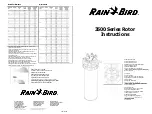
VGEM000-GB192
VGE International B.V.
●
Ekkersrijt 4304
●
5692 DH Son Netherlands
●
+31 499 461099
●
●
www.vgebv.nl
Pag. 21/68
Installation & User Manual
2.7 Lamp breakage
The UV lamps which are used in the VGE Pro UV systems that are fragile and therefore need to be treated
with great care. The storage of UV lamps must also be done in the original packaging to protect the lamps.
UV lamps contain a small amount of mercury (milligrams). Mercury is a metal that is
liquid at room temperature and is generally poorly absorbed when ingested. The
mercury vapor, on the other hand, is well absorbed by inhalation and is very toxic. It
is therefore important not to allow mercury to come into contact with skin or hair and
to properly ventilate the area where mercury has been released and not to breathe
the vapours.
When a UV lamp is broken, mercury can be released, this must be collected and processed as chemical
waste. The droplets of mercury are difficult to collect, but with a special mercury collector (see chapter
'Mercury collector') this is possible. A mercury ball can also be covered with sulphur powder, which gives it
a solid shape and can be easily cleaned up. In this state, evaporation no longer occurs.
Mercury can also be released with a special mercury sponge and disposed of as chemical waste.
During service work with UV lamps, protective gloves and eye protection (preferably a face mask) must be
worn to prevent possible injury.
The UV lamps built into the irradiation chamber are properly mounted, but there are a number of reasons
why UV lamps can break during the UV-C irradiation process:
- Fixed parts/objects that are passed through the irradiation chamber with the water;
- Overheating of the irradiation chamber;
- Mechanical vibrations of the pipe network in which the irradiation chamber is mounted;
- At high water flow rates through the irradiation chamber, possibly causing vibrations due to cavitation.
Follow the instructions in this manual for replacing a UV lamp, if the quartz tube is also damaged, follow the
instructions for replacing a quartz tube as described in this manual.
2.8 Electrical isolation
The UV system works with a high voltage which can be life threatening when touched. If work is to be
carried out on the UV system, the system must be electrically insulated (de-energized) prior to the start by
removing the power cable plug from the socket.
2.9 Electrical grounding
The UV system, control panel and irradiation chamber must be earthed in
accordance with local rules and laws.
In addition to good safety, good grounding of the irradiation chamber reduces the
risk of possible electrolytic corrosion.
















































